EVENINGS ALONG HE STREAM (part 4)
| Sysadmin Note |
|---|
| Part Three can be found here |
The morning of June 25th, 2011 dawned clear and at 7:30 A.M. the air temperature was a balmy 45 degrees, those cool temperature ensured that there was no early morning surface action. The Yellowstone River was holding steady and had not overrun the spring creeks, today we would once again be fishing the fabled waters of Armstrong's Spring Creek. The anglers I was fishing had started their trip on the 18th of June and they had put in long hours and had decided that today was going to be conduct in a more leisurely manner.
Between 7:30 A.M. and 10:30 A.M. we didn't see a lot of feeding activity of any kind; however I will admit that no one was really looking all that hard. We talked flies and fly designs and what we thought were the best patterns while drinking coffee and just enjoying the morning on the stream, we watch the ducks feed and listened to the calls of the Peacocks. We did notice that much of the bird life that is normally along the stream feeding on insects were doing as we were, sitting quietly along the bank waiting for things to happen.
Finally we noticed that the trout had moved into their feeding stations and were beginning to nymph, today we were fishing the area downstream from the culvert this is some of the water that is a series of riffles and pools leading down to the center section of the creek. We check the water and discovered that the PMD nymphs were beginning move off the bottom and out of the weed beds. There is section of the creek where there is a big rock, a riffle and small pool where you can approach very close to the trout and you can actually see the nymphs as they come to the surface, the angle of vision is just excellent.
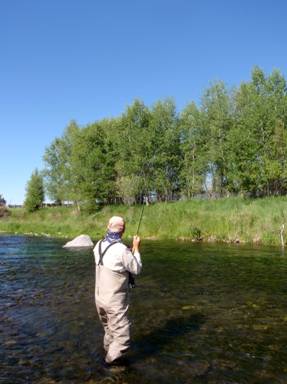
As they began to fish, I was able to approach the feeding zone without disturbing the feeding trout and what I seen was indeed interesting. I tried to get photograph by they didn't come out so you are stuck with crude drawings of what we seen with the hatching nymphs.
This is the area on Armstrong's allows for some excellent observation it is one of the fantastic viewing spots, where you can watch the insects, the trout and how the insects hatch and how the trout feed on them.
Pretty soon both anglers had taken several trout and move up to my position so they could watch the insects, we all found this very interesting. Now I know that some of you will believe that we are all crazy, why would you stop fishing to watch the "Bugs", sometimes you can learn or gain a better understanding of a situation by watching rather than fishing.
However we only watched for a few minutes and then returned to fishing, today we had a reason PMD hatch where we were able to move the nymph up through the water column and finally switch to emergers and finally to duns as the hatch began to fade. Finally by 2:45 P.M. the water was quiet and we head in for a late lunch and a discussion of what we had watched.
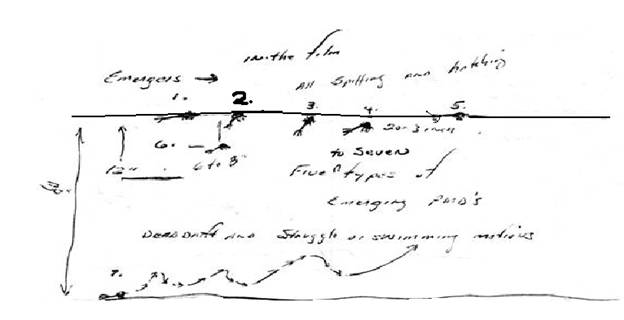
Have you ever wondered why several types of patterns will work in any given situation? A little time devoted to observation will answer that question as you will see by looking at the drawing from my fishing journal. I have numbered the drawings so that my explanations will have some semblances' of organization. First off all of the nymphs were Pale Morning Dun either Ephemerella inermis or E. infrequens, also all of the current information on the hatching or emerging of these insect points to no differences between the species.
The nymph was observed floating with the abdomen under the film and the thorax in the film.
The nymph was observed in a semi curled position just under the surface film.
Here the nymph was observed hanging almost straight down with the head and very tip of the thorax poking through the film, during the hatching process.
This nymph was observed hatching out beneath the surface of the water at a depth of two or three inches.
This nymph was actually on the top of the surface film, during the emergence process.
This nymph also hatched beneath the surface of the water at depth of six to eight inches, swam to the surface and crawled out on the surface film looking somewhat wet and bedraggled.
This nymph was observed coming off the bottom and could be seen struggling or swimming and then dead drifting as it worked its way to the surface. We were unable to see the hatching as a six inch rainbow trout dart in and consumed the nymph ending the observation.
Now you should understand why so there are so many effective patterns which can be used to imitate the emerging nymphs. The following is some of basic pattern styles that I have found effective and any of these styles can be used on any mayfly that hatches in the matter by simply matching the size and colors of the naturals to the imitation.
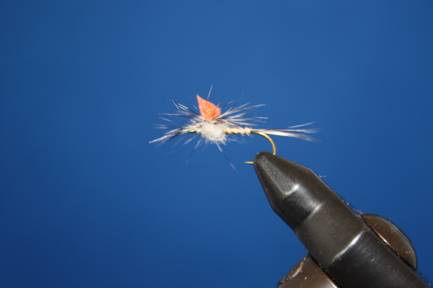
Parachute PMD Surface Emergers
- Hook: TMC 101
- Sizes: 14-20
- Thread: 12/0 Sandy Dun
- Hook: TMC 2487 14-20
- Tails: Lite Dun Dry Fly Hackle Fibers
- Abdomen: Turkey Wing Quill Fibers, dyed PMD
- Wingpost: Yellow Dry Cell Fly Foam
- Hackle: Lite Dun Dry Fly Hackle, Tied Parachute Style
- Thorax: Dubbed, Scintilla #15 Pale Yellowy/Olive
Note: This pattern can also be tied with Brown and BWO Turkey wing quill fiber abdomens. I have used the pattern as both an emerger and a parachute spinner with equal success. You could also use a rolled shuck dubbing, of Scintilla #30 Pale Olive Brown
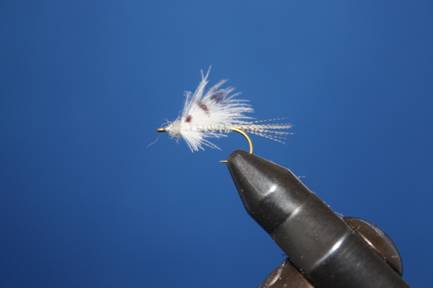
CDC PMD Surface Emergers
- Hook: TMC 101 Sizes: 14-20
- Thread: 12/0 Sandy Dun
- Hook: TMC 2487 14-20
- Tails: Lite Dun Dry Fly Hackle Fibers
- Abdomen: Turkey Wing Quill Fibers, dyed PMD
- Wings & Legs: Lite Dun CDC
- Head: Dubbed, Scintilla #15 Pale Yellowy/Olive
Note: This pattern can also be tied with Brown and BWO Turkey wing quill fiber abdomens.
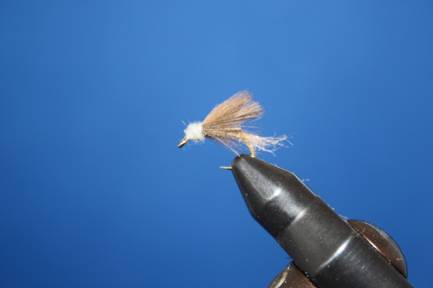
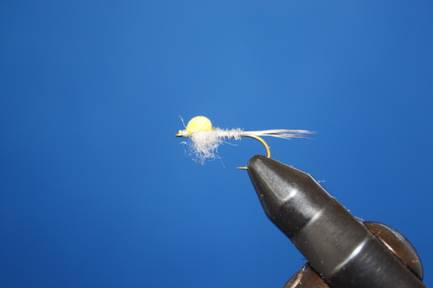
PMD Foam Floating Nymph
- Hooks: TMC 101 Sizes: 14-20 / TMC 2487 14-20
- Thread: 12/0 Sandy Dun
- Tails: Lite Dun Dry Fly Hackle Fibers
- Abdomen: Turkey Wing Quill Fibers, dyed PMD
- Wingcase: Yellow Dry Cell Fly Foam
- Thorax: Dubbed, Scintilla #15 Pale Yellowy/Olive
Notes: This pattern can be also tied with Brown or BWO Turkey Wing Quill Fibers abdomens. For tails you can use a rolled dubbing shuck (Scintilla #30 Pale Olive/Brown) or a trimmed dry fly hackle tail, using a Lite Dun hackle stem or a Grizzly Dyed olive hackle stem.
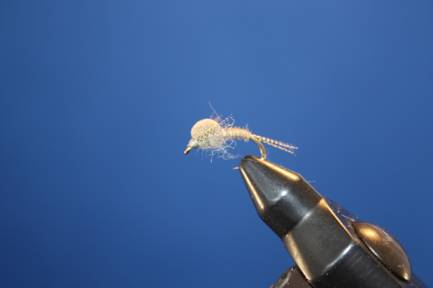
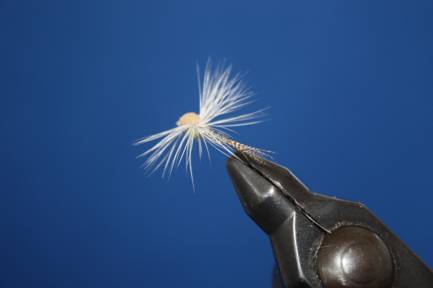
Parachute PMD Nymph Emerger
- Hook: TMC 101 Sizes: 14-20 / TMC 2487 14-20
- Thread: 12/0 Sandy Dun
- Tails: Wood Duck Flank Fibers
- Abdomen: Turkey Wing Quill Fibers, dyed PMD
- Wingcase: Yellow Dry Cell Fly Foam
- Hackle: Lite Dun Hackle tied parachute style
- Thorax: Dubbed, Scintilla #15 Pale Yellowy Olive
Note: The tails can be changed to a rolled dubbing shuck or trimmed hackle stem. The abdomen colors can be changed by using BWO, Brown or Rusty Turkey wing quill fibers. The hackle color can be changed to grizzly dyed olive or bleached grizzly.
The only patterns included in this section are surface type emergers, the imitations of subsurface emergers will be covered in another section.
| Sysadmin Note |
|---|
| Part Five can be found here |
